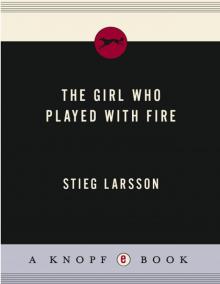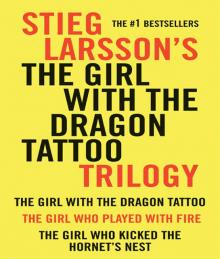- Home
- Stieg Larsson
Millennium 02 - The Girl Who Played with Fire Page 31
Millennium 02 - The Girl Who Played with Fire Read online
Page 31
“Which suggests that maybe we should change our approach,” Bublanski said. “With accomplices, she could have slipped out of the country, but it’s more probable that she’s gone to ground.”
Bohman held up his hand. Bublanski nodded to him.
“The profile we have of her is that she’s self-destructive. On the other hand, she’s a strategist who plans all her actions carefully. She does nothing without analysing the consequences. At least that’s what Dragan Armansky thinks.”
“That was the assessment her one-time psychiatrist gave as well. But let’s hold off on the characterization for a while,” Bublanski said. “Sooner or later she’ll have to make a move. Jerker, what sort of resources does she have?”
“Now here’s something you can sink your teeth into,” Holmberg said. “She’s had a bank account for several years at Handelsbanken. That’s the income she declares. Or rather, the income that her guardian, Nils Bjurman, declared. A year ago the account held about 100,000 kronor. In the autumn of 2003 she withdrew the entire amount.”
“She needed cash in the autumn of 2003. That was when she stopped working for Milton Security,” Bohman said.
“Possibly. The account stood at zero for about two weeks. And then she put the same amount back into it.”
“She thought she needed money for something, but she didn’t spend it and put the money back?”
“Possibly. In December 2003 she used the account to pay a number of bills, including her rent for a year in advance. The account dropped to 70,000 kronor. After that the account wasn’t touched for a year, except for a deposit of around 9,000 kronor. I’ve checked—it was an inheritance from her mother. In March this year she took out this sum—the exact amount was 9,312 kronor—and that’s the only time she’s touched the account.”
“So what the hell does she live on?”
“Listen to this. In January of this year she opened a new account. This one at Svenska Enskilda Banken. She deposited two million kronor.”
“Where did the money come from?” Modig asked.
“The money was transferred to her account from a bank in the Channel Islands.”
Silence descended over the conference room.
“I don’t understand any of this,” Modig said after a moment.
“So this is money she hasn’t declared?” Bublanski asked.
“No, but technically she doesn’t have to until next year. What’s interesting is that the sum is not recorded in Bjurman’s report on her assets, and he filed a report every month.”
“So—either he didn’t know about it or else they were running a scam together. Jerker, where do we stand on forensics?”
“I had a report from the leader of the preliminary investigation yesterday evening. This is what we know. One: we can tie Salander to both crime scenes. We found her fingerprints on the murder weapon and on the shards of a broken coffee cup in Enskede. We’re waiting for results from all the DNA samples we gathered, but there’s no doubt that she was there in the apartment. Two: we have her prints on the box we found in Bjurman’s apartment, the one the gun came in. Three: we finally have a witness who can place her at the site of the murders in Enskede. The owner of a corner shop telephoned to say that Salander was definitely in his shop on the night of the murders. She bought a pack of Marlboro Lights.”
“And he comes out with this days after we asked the public for information?”
“He was away over the holidays, like everybody else. In any case”—Holmberg pointed at a map—“the corner shop is here, about two hundred yards from the crime scene. She came in just as he was closing at 10:00 p.m. He gave a perfect description of her.”
“Tattoo on her neck?” Andersson said.
“He was a bit vague about that. He thought he saw a tattoo. But he definitely saw that she had a pierced eyebrow.”
“What else?”
“Not that much in the way of technical evidence. But it should hold up.”
“Faste—the apartment on Lundagatan?”
“We’ve got her prints, but we don’t think she lives there. We’ve turned the place upside down, and it seems that a Miriam Wu is living there. Her name was added to the contract as recently as February this year.”
“What do we know about Wu?”
“No police record. Known lesbian. She appears in shows at the Gay Pride Festival. Seems to be studying sociology and is part owner of Domino Fashion, a sex shop on Tegnérgatan.”
“Sex shop?” Modig said with raised eyebrows.
On one occasion she had bought, to her husband’s delight, some sexy lingerie at Domino Fashion. And she had absolutely no intention of revealing that to the men in the room.
“Yeah, they sell handcuffs and whore outfits and stuff like that. Need a whip?”
“It’s not a sex shop. It’s a fashion boutique for people who like sexy underwear.”
“Same shit.”
“Go on,” Bublanski said angrily. “Is there any sign of Fröken Wu?”
“Not a trace.”
“She could have gone away for Easter,” Modig said.
“Or else Salander whacked her too,” Faste said. “Maybe she wants to make a clean sweep of all her acquaintances.”
“Wu is a lesbian. Should we conclude that she and Salander are a couple?”
“I think we can draw the conclusion that there’s a sexual relationship,” Andersson said. “First, we found Salander’s prints on and around the bed in the apartment. We also found her prints on a pair of handcuffs.”
“Then she’ll appreciate the cuffs I’ve got ready for her,” Faste said.
Modig groaned.
“Go on,” Bublanski said to Andersson.
“We got a tip that Miriam Wu was seen at Kvarnen kissing a girl who matched Salander’s description. That was about two weeks ago. The informant claimed that he knows who Salander is and has run into her there before, although he hadn’t seen her in the past year. I haven’t had time to double-check with the staff, but I’ll do it this afternoon.”
“In her casebook at social welfare it doesn’t mention a thing about her being a lesbian. A number of times in her teens she ran away from her foster families and picked up men in bars. She was noticed by the police several times in the company of older men.”
“Which doesn’t mean shit if she was a whore,” Faste said.
“What do we know about people she knows? Curt?”
“Hardly anything. She hasn’t had a run-in with the police since she was eighteen. She knows Dragan Armansky and Mikael Blomkvist, we know that much. And she knows Miriam Wu, of course. The same source that tipped us off about her and Wu at Kvarnen says that she used to hang out with a bunch of girls there a while back. Some kind of girl band called Evil Fingers.”
“Evil Fingers?” Bublanski repeated.
“Seems to be something occult.”
“Don’t tell me Salander is some damned Satanist too,” Bublanski said. “The media are going to go nuts.”
“Lesbian Satanists,” Faste said helpfully.
“Hans, you’ve got a view of women from the Middle Ages,” Modig said. “Even I’ve heard of Evil Fingers.”
“You have?” Bublanski said.
“It was a girl rock band in the late nineties. No superstars, but they were pretty famous for a while.”
“So, hard-rocking lesbian Satanists,” Faste said.
“OK, enough goofing around,” Bublanski said. “Hans, you and Curt check out who was in Evil Fingers and talk to them. Does Salander have any other friends?”
“Not many, other than her former guardian, Holger Palmgren. He’s in long-term care now after a stroke and is apparently unwell. To be honest, I can’t say that I found any circle of friends, though we haven’t seen her address book. For that matter, we still don’t know where she lives.”
“Nobody can go around without leaving traces, like some kind of ghost. What do we think about Mikael Blomkvist?”
“We haven’t had him under direct surveillance
, but we’ve checked in with him off and on over the holiday,” Faste said. “On the chance that Salander might pop up, that is. He went home after work on Thursday and doesn’t seem to have left his apartment all weekend.”
“I can’t see him having anything to do with the murders,” Modig said. “His story holds up, and he can account for every minute of that night.”
“But he does know Salander. He’s the link between her and the couple in Enskede. And besides, we have his statement that a man attacked Salander a week before the murders took place. What are we supposed to make of that?” Bublanski said.
“Other than the fact that Blomkvist was the only witness to the attack?” Faste said.
“You think Blomkvist is imagining things or lying?”
“Don’t know. But it sounds to me like a bullshit story. How come a full-grown man couldn’t take care of a tiny girl who weighs less than ninety pounds?”
“Why would Blomkvist lie?”
“To muddle our thinking about Salander?”
“But none of this really adds up. Blomkvist’s hypothesis is that his friends were killed because of the book that Svensson was writing.”
“Bullshit,” Faste said. “It’s Salander. Why would anybody murder their guardian to shut Dag Svensson up? And who else could it be … a policeman?”
“If Blomkvist goes public with his hypothesis, we’re going to see a hell of a lot of police conspiracy theories,” said Andersson.
Everyone at the table murmured agreement.
“All right,” Modig said. “Why did she shoot Bjurman?”
“And what does the tattoo mean?” Bublanski said, pointing at a photograph of Bjurman’s lower abdomen.
I AM A SADISTIC PIG, A PERVERT, AND A RAPIST.
“What does the pathologist’s report say?” Bohman said.
“The tattoo is between one and three years old. That’s measured by the extent of bleed-through in the skin,” Modig said.
“I think we can rule out the likelihood of Bjurman actually having commissioned it.”
“There are plenty of crazies around, but it can hardly be a standard motif among tattoo enthusiasts.”
Modig waved her index finger. “The pathologist says that the tattoo has to have been done by a rank amateur. The needle penetrated to different depths, and it’s a very large tattoo on a sensitive part of the body. All in all, it must have been a very painful procedure, comparable to aggravated assault.”
“Except for the fact that Bjurman never filed a police report,” Faste said.
“I wouldn’t file a police report either, if somebody tattooed that on me,” Andersson said.
“One more thing,” Modig said. “And this might reinforce the confession, as it were, in the tattoo.” She opened a folder of photographic printouts and passed them around. “I printed out some samples from a folder on Bjurman’s hard drive. They’re downloaded from the Internet. His computer contains about two thousand images of a similar nature.”
Faste whistled and held up a photograph of a woman bound in a brutally uncomfortable position. “This may be something for Domino Fashion or Evil Fingers,” he said.
Bublanski gestured in annoyance for Faste to shut up.
“What are we supposed to make of this?” Bohman said.
“Suppose the tattoo is about two years old,” Bublanski said. “It would have been done around the time that Bjurman got sick. No medical records indicate that he had any illness, other than high blood pressure. So we can assume that there was a connection.”
“Salander changed during that year,” Bohman said. “She stopped working for Milton and without warning, I understand, went overseas.”
“Should we assume that there’s a connection there too? The message in the tattoo plainly says that Bjurman raped someone. Salander is a likely victim. And that would be a motive for murder.”
“There are other ways to interpret this, of course,” Faste said. “I can imagine a scenario where Salander and the Chinese girl are running some sort of escort service with S&M overtones. Bjurman could be one of those nuts who gets off on being whipped by small girls. He could have been in some sort of dependence relationship with Salander and things went wrong.”
“But that doesn’t explain what she was doing in Enskede.”
“If Svensson and Johansson were about to expose the sex trade, they may have stumbled on Salander and Wu. That may be your motive for Salander to commit murder.”
“So far this is mere speculation,” said Modig.
The meeting went on for another hour, and also dealt with the fact that Svensson’s laptop was missing. When they broke for lunch they were all frustrated. The investigation was fraught with more question marks than ever.
Berger called Magnus Borgsjö, CEO of Svenska Morgon-Posten, as soon as she reached the office on Tuesday morning.
“I’m interested,” she said.
“I thought you would be.”
“I meant to let you know right after the Easter holiday. But as you’ll have heard, chaos has broken out here.”
“The murder of Dag Svensson. I’m so sorry. A terrible thing.”
“Then you’ll understand that this is no time for me to announce my resignation.”
He was silent for a moment.
“We have a problem,” Borgsjö said. “The last time we spoke, we said that the job would start on August 1. But the thing is, our editor in chief, Håkan Morander, whom you would be replacing, is in very poor health. He has heart problems and has to cut back on work. He talked to his doctor a few days ago, and this weekend I learned that he’s now planning to retire on July 1. The idea was that he would still be here until fall, and that you could work in tandem through August and September. But the way the situation looks now, we have a crisis. Erika—we’re going to need you to start on May 1, and certainly no later than May 15.”
“God. That’s only weeks away.”
“Are you still interested?”
“Yes, of course … but that means I have only a month to tidy things up here at Millennium.”
“I know. I’m sorry to do it, Erika, but I have to rush you. A month should be enough time to straighten out affairs at a magazine with only half a dozen employees.”
“But it means leaving in the midst of a crisis.”
“You’d have to leave in any case. All we’re doing is bringing forward your departure date by a few weeks.”
“I do have some conditions.”
“Let me hear them.”
“I’ll have to remain on Millennium’s board of directors.”
“That might not be appropriate. Millennium is much smaller, of course, and a monthly magazine besides, but technically we’re competitors.”
“That can’t be helped. I won’t have anything to do with Millennium’s editorial work, but I won’t sell my share of the business. So I have to stay on the board.”
“OK, we can probably deal with that.”
They agreed to meet with his board during the first week of April to iron out the details and draw up a contract.
Blomkvist had a feeling of déjà vu when he studied the list of suspects that he and Eriksson had put together over the weekend. Thirty-seven names, all people Dag Svensson was leaning on hard in his book, twenty-one of whom were johns he had identified.
It reminded Blomkvist of the gallery of suspects from when he had set out to track a murderer in Hedestad two years before.
At 10:00 on Tuesday morning he asked Eriksson to come into his office at Millennium. He closed the door behind her. They sat for a few moments, drinking their coffee. Then he passed her the list of names.
“What should we do?” Eriksson said.
“First we have to show the list to Erika—maybe in ten minutes. Then we have to check them off one by one. It’s possible, it’s even probable, that one of these people has a connection to the murders.”
“And how do we check them off?”
“I’m thinking of focusing on the twenty
-one johns. They have more to lose than the others. I’m thinking of following in Dag’s footsteps, of going to see them one by one.”
“And what do I do?”
“Two jobs. First, there are seven people here who aren’t identified. Your assignment over the next couple of days is to try and identify them. Some of the names are in Mia’s thesis; there may be ways of cross-referencing that would help you work out their real identities. Second, we know very little about Nils Bjurman, Lisbeth’s guardian. There was a brief CV in the papers, but my guess is that half of it is made up.”
“So I should ferret out his background.”
“Precisely. Everything you can find.”
Harriet Vanger called Blomkvist at 5:00 in the afternoon.
“Can you talk?”
“For a minute.”
“This girl the police are looking for … it’s the same one who helped you track me down, isn’t it?”
Harriet Vanger and Salander had never met.
“That’s right,” Blomkvist said. “I’m sorry I haven’t had time to call and update you. But, yes, she’s the one.”
“What does it mean?”
“As far as you’re concerned? Nothing, I hope.”
“But she knows everything about me and what happened.”
“Yes, she knows everything that happened.”
Harriet was quiet on the other end of the line.
“Harriet, I don’t think she did it. I’m working on the assumption that she’s innocent of all these murders. I trust her.”
“If I’m to believe what’s in the newspapers, then—”
“But you shouldn’t believe what’s in the papers. And as far as it affects you, it’s quite simple: she gave her word that she would keep her mouth shut. I believe she’ll keep that promise for the rest of her life. Everything I know about her tells me that she is extremely principled.”
“And if she didn’t do it?”
“I don’t know. Harriet, I’m doing everything in my power to discover what actually happened. Don’t worry.”
“I’m not worried, but I do want to be prepared for the worst. How are you holding up, Mikael?”
“So-so. We’ve been going nonstop.”
“Mikael… I’m in Stockholm right now. I’m flying to Australia tomorrow—I’ll be gone for a month.”

 The Girl with the Dragon Tattoo
The Girl with the Dragon Tattoo The Girl Who Kicked the Hornet's Nest
The Girl Who Kicked the Hornet's Nest The Girl Who Played with Fire
The Girl Who Played with Fire The Girl with the Dragon Tattoo m(-1
The Girl with the Dragon Tattoo m(-1 The Girl who played with Fire m(-2
The Girl who played with Fire m(-2 Millennium 01 - The Girl with the Dragon Tattoo
Millennium 01 - The Girl with the Dragon Tattoo The Girl Who Kicked The Hornets’ Nest m(-3
The Girl Who Kicked The Hornets’ Nest m(-3 Millennium 02 - The Girl Who Played with Fire
Millennium 02 - The Girl Who Played with Fire Millennium 03 - The Girl Who Kicked the Hornet's Nest
Millennium 03 - The Girl Who Kicked the Hornet's Nest The Girl With the Dragon Tattoo Trilogy Bundle
The Girl With the Dragon Tattoo Trilogy Bundle![Millenium [02] The Girl Who Played With Fire Read online](http://i1.bookreadfree.com/i2/04/12/millenium_02_the_girl_who_played_with_fire_preview.jpg) Millenium [02] The Girl Who Played With Fire
Millenium [02] The Girl Who Played With Fire